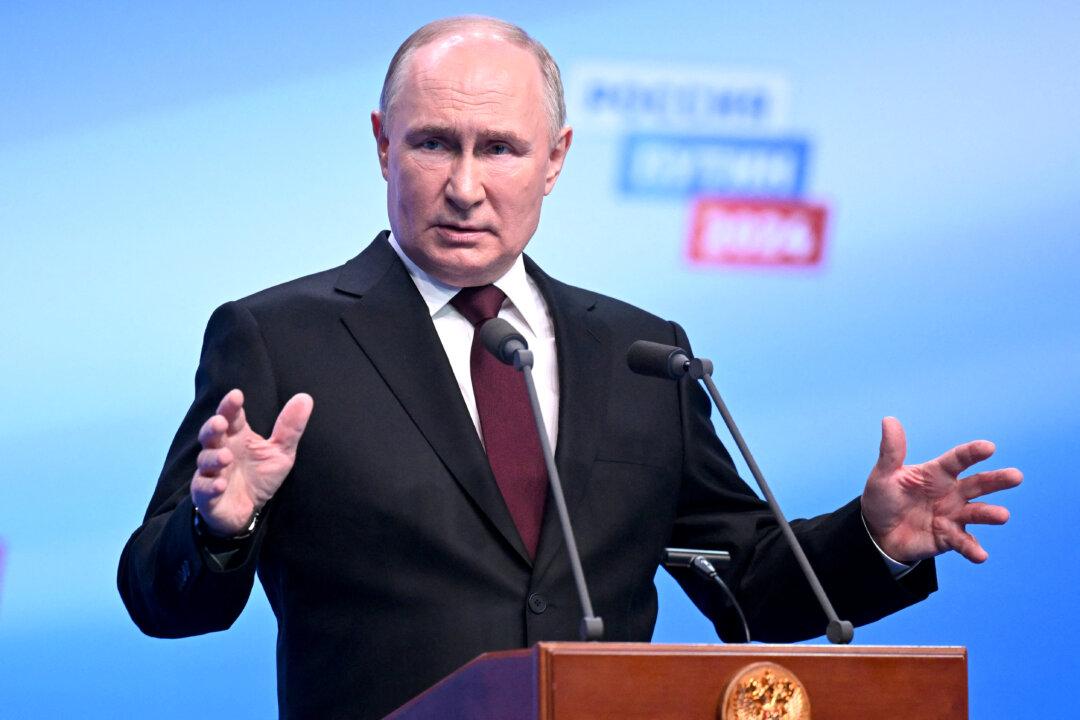Russia is thinking of creating a “buffer zone” along its border with northeastern Ukraine amid persistent cross-border attacks on its western Kursk and Belgorod regions.
“I don’t rule out the possibility that we will be forced at some point ... to create a ‘sanitary zone’ in the territories that are currently under the Kyiv regime,” Russian President Vladimir Putin said on March 18.
Over the weekend, Mr. Putin secured another six-year presidential term in a three-day election that he reportedly won in a landslide.
In remarks cited by Reuters, Mr. Putin, Russia’s leader for almost 25 years, said the proposed “sanitary zone” should be large enough to prevent incursions by Western-made armaments into Russian territory.
His comments follow days of persistent attacks—carried out from northeastern Ukraine—on Kursk, Belgorod, and other western regions of Russia.
According to Moscow, the attacks, which have gradually waned in intensity, were largely intended to disrupt the March 15–17 election.
Ukrainian forces were targeting Belgorod “with the obvious aim of derailing the poll and intimidating voters,” Russia’s Foreign Ministry said on the second day of the vote.
Kyiv has attributed the cross-border attacks to three Ukraine-based paramilitary groups that it claims are composed of Russian nationals opposed to Mr. Putin.
Ukrainian officials say the three groups—the “Freedom of Russia Legion,” the “Siberian Battalion,” and the “Russian Volunteer Corps”—all act independently of Kyiv.
Russian officials have sought to portray the three groups, about which very little is publicly known, as proxies for U.S. and Ukrainian intelligence agencies.
Over the weekend, Kyrylo Budanov, head of Ukraine’s military intelligence apparatus, claimed that the three groups were fighting “quite well” and had no plans to call off their attacks.
“We will try to help them to the best of our ability,” Mr. Budanov said in televised comments broadcast on March 16.
A day before the attacks began, Russia’s Foreign Intelligence Service accused the United States—in coordination with Kyiv—of hatching plans to derail the election.
It did not provide evidence for its assertions.
A White House National Security Council spokesperson called the Russian claims “categorically false” and “propaganda.”
“The United States has not—and will not—meddle in Russia’s election,” the spokesperson said on March 12.

Tit-for-Tat Strikes
On March 13, Russia’s Defense Ministry claimed to have thwarted multiple attempts by forces originating in Ukraine to cross the border into both Kursk and Belgorod.It later claimed that upward of 550 Ukrainian troops had been killed during the failed incursions and that a large number of armored vehicles—including tanks—had been destroyed by Russian aircraft and artillery.
Nevertheless, the attacks continued—with varying degrees of success—over the next several days.
On March 14, a Ukrainian intelligence official told Reuters that cross-border attacks by the three Russian dissident groups had turned Kursk and Belgorod into “active combat zones.”
The ground assaults, all of which were ultimately thwarted by Russian forces, were accompanied by a hail of drone and missile attacks on targets inside Russian territory.
According to Russian military officials, most incoming missiles and drones were successfully downed by air defenses.
However, some got through, with one striking an oil refinery in Nizhny Novgorod and another hitting a fuel storage facility in the nearby Oryol region.
Along with significant material damage, 11 people were killed in Belgorod and scores more were injured, local officials said on March 18.
It was the largest wave of attacks on Russian territory since December 2023, when a similar series of missile and drone strikes reportedly killed 25 people in Belgorod.
“Against the backdrop of drone attacks and the shelling of our territory ... measures must be taken to secure these [western] territories,” Kremlin spokesman Dmitry Peskov said.
Russia’s border regions “can only be secured by creating some kind of buffer zone so that the means that the enemy uses to strike us remain out of range,” Mr. Peskov told reporters on March 18.
On the same day, Kyiv reported dozens of Russian artillery attacks near the two countries’ shared border.
According to military officials in Ukraine’s northeastern Sumy region, several border settlements were repeatedly targeted by cross-border Russian artillery fire.
At least one person was killed in the Velykopysarivska settlement and several buildings had also been damaged, they said.
In Ukraine’s northeastern Kharkiv region, which shares a border with Belgorod, Russian aerial bombs struck a residential area, damaging buildings and vehicles, according to local officials.
The Epoch Times could not independently verify claims made by either side of the conflict.







